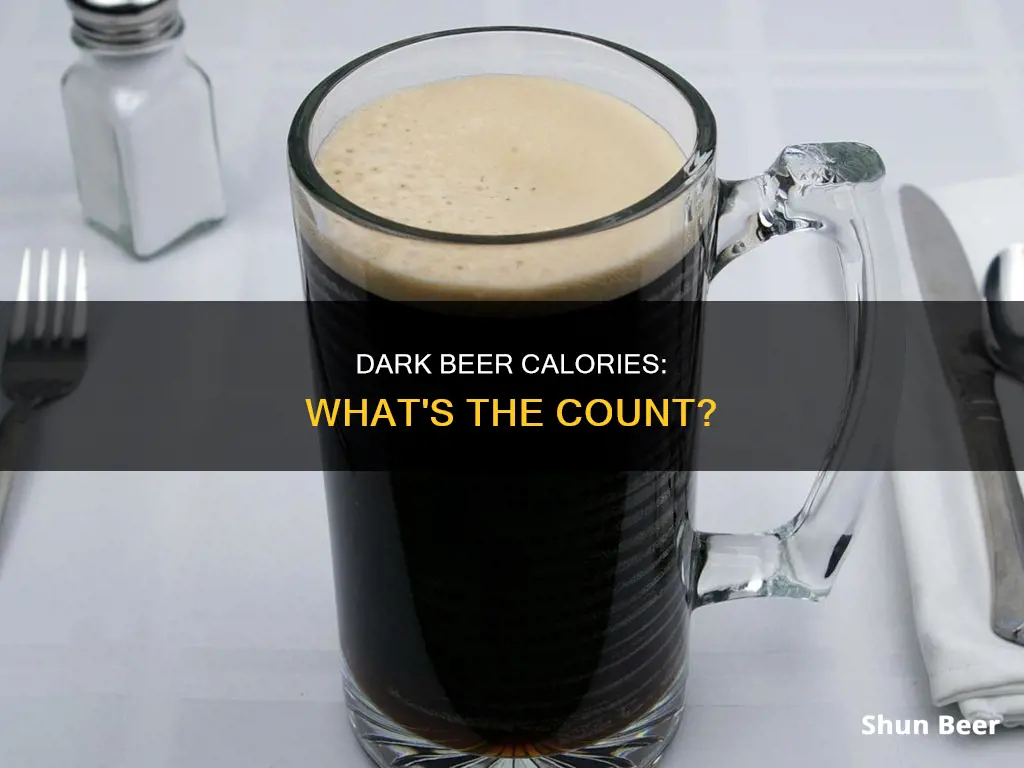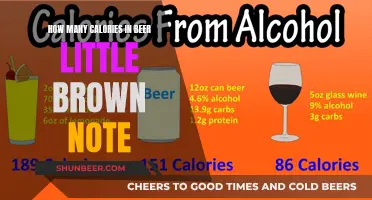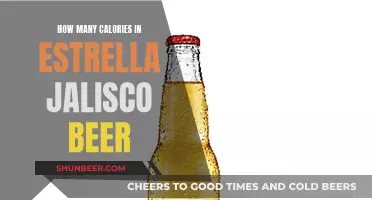
Despite common misconceptions, the colour of a beer is not directly related to its calorie content. While dark beers are often assumed to be rich, heavy, and calorie-dense, the sugar and calorie content of a beer is directly correlated with its alcohol content. A bottle of dark beer from the Waterloo Brewing Co. contains 148 calories, while a 12-ounce serving of a dark beer with 4.9% ABV is estimated to contain under 200 calories. In contrast, a pale beer with a higher ABV of 9.5% can contain over 300 calories per 12-ounce serving.
What You'll Learn

Dark beer misconceptions: colour does not equal calories
It is a common misconception that dark beers are heavier and have more calories than lighter-coloured beers. While it is true that darker beers tend to have more robust flavours, such as chocolate, coffee, caramel, and roasted malts, this does not necessarily mean that they are higher in calories. In fact, the colour of a beer is primarily related to its malt content and the roasting process, with darker malts yielding deeper colours and richer flavours.
The misconception likely stems from the association of dark beers with higher alcohol content, which is often accurate. However, it is important to understand that the calories in beer are directly correlated with its alcohol content. The more alcohol a beer has, the more maltose (sugar) was used in the brewing process, resulting in a higher-calorie beverage. So, while some dark beers may be higher in calories due to their higher alcohol content, this is not solely due to their colour.
For example, a Belgian-style tripel, known for its pale colour and high carbonation, can have an ABV of 9.5% and over 300 calories in a 12-ounce serving. On the other hand, a light-bodied dark lager with a lower ABV of 4.9% may have under 200 calories in the same serving size. This illustrates that colour is not the determining factor for calorie content in beer.
Additionally, the style of beer also plays a role in calorie content. For instance, black lagers, porters, and dry stouts tend to be on the lower end of the ABV spectrum, typically ranging from 4.2% to 6%, resulting in a lower calorie count. These styles also showcase the unique flavours that darker malts can contribute without being overly heavy or high in alcohol.
So, the next time you're looking for a lower-calorie beer, don't be afraid to explore the darker options. By considering factors such as ABV and beer style, you can enjoy the robust flavours of a dark beer without sacrificing your calorie intake.
Calories in Beer: Understanding the Nutritional Breakdown
You may want to see also

ABV and calories: the higher the ABV, the more calories
Many people assume that dark beers are heavy and full of calories. However, this is a misconception, as the colour of a beer is directly related to its malt content, and dark malts typically only make up 1-5% of the overall recipe. In fact, the calories in beer are directly correlated to its alcohol content, as it takes more sugar to make more alcohol. Therefore, the higher the ABV, the more calories a beer will have.
For example, a 12-oz serving of Golden Monkey, a Belgian-style tripel with a high ABV of 9.5%, is estimated to contain over 300 calories. On the other hand, a 12-oz serving of Samuel Adams' Black Lager, a light-bodied beer with a low ABV of 4.9%, is estimated to contain under 200 calories. Similarly, a bottle of Waterloo Dark Beer, with an ABV of 4.8%, contains 148 calories.
The relationship between ABV and calories can also be seen when comparing different types of beer. For instance, IPAs tend to have a higher ABV and therefore more calories, with one commenter on a calorie-tracking thread noting that they can only enjoy these beers occasionally. Additionally, high ABV pastry stouts can contain up to 600-650 calories due to their residual sugar content.
When it comes to dark beers specifically, lower ABV options such as stouts and porters tend to have fewer calories. For example, Young's Double Chocolate Stout has approximately 150 calories per bottle, and Samuel Smith's Oatmeal Stout, Organic Chocolate Stout, and Taddy Porter all have an ABV of 5% and are recommended as lower-calorie options. However, it's important to note that lower ABV often means less full flavour, as these robust flavours are sugar-based and difficult to achieve in a low ABV beer.
Calories in Amber Bach Beer: Nutritional Facts Explored
You may want to see also

Dark stouts: lower-calorie options
If you're a fan of dark stouts, you may have noticed that they tend to be associated with a higher calorie count. This is often due to the presence of rich, sweet flavours like coffee, caramel, and chocolate, which are derived from sugar. However, there are some lower-calorie options available that can provide a similar flavour profile without the extra calories.
One option is to look for beers with a lower alcohol content. Alcohol is a byproduct of fermented sugar, so beers with a lower ABV will generally have fewer calories. For example, Guinness is known for being a relatively low-calorie option, with an ABV of just over 4%. Other options in this ABV range include Samuel Smith's Oatmeal Stout, Organic Chocolate Stout, and Taddy Porter, all of which come in at 5% ABV. While the exact calorie count of these beers is not provided, a quick rule of thumb is to multiply the ABV by 30 to get an estimate of the calorie content. So, a 5% ABV beer would be estimated to have around 150 calories.
Another beer suggested for its lower calorie content is Odell's Cutthroat Porter, although the exact calorie count and ABV are not provided. Similarly, Calm Before the Storm from Ballast Point is recommended as a lower-calorie option, but again, specific details are not given.
In addition to ABV, the presence of certain adjuncts can also impact the calorie count of a beer. However, it's important to note that not all breweries provide detailed nutritional information, so it can be challenging to determine the exact calorie content of some beers. Nonetheless, by considering both ABV and the presence of adjuncts, you can make more informed choices when it comes to selecting lower-calorie dark stouts.
Wheat Beer Calories: What's the Count?
You may want to see also

Calorie estimates: 250-300 calories per beer
While the number of calories in dark beer varies, a good rule of thumb is to assume that most beers fall within the range of 250 to 300 calories per beer. This estimate suggests that a standard beer contains approximately 25 to 30 calories per ounce, which can quickly add up to a significant number of extra calories each week. For example, consuming ten 300-calorie beers per week amounts to an additional 3000 calories.
It's important to note that the calorie content of beer can vary depending on factors such as alcohol content, with higher-alcohol beers tending to have more calories. For instance, a highly carbonated Belgian-style tripel with a high ABV of 9.5% can contain over 300 calories in a 12-ounce serving. On the other hand, a light-bodied beer with a lower ABV of 4.9% or less is likely to have under 200 calories in the same serving size.
The style of beer also plays a role in its calorie content. Dark beers, such as stouts and porters, are often associated with robust flavours like chocolate and coffee, which are derived from residual sugars. While these beers may have lower alcohol content, contributing to a lower calorie count, the presence of these sugar-based flavours can increase the overall calorie density.
Additionally, it's worth mentioning that serving size can significantly impact the calorie intake. A standard serving size for beer is typically considered to be 12 ounces, but larger servings or multiple servings can substantially increase the number of calories consumed. Therefore, it's essential to be mindful of both the calorie content per ounce and the serving size when estimating the total calorie intake from beer.
To put this into perspective, let's consider an example. A bottle of dark beer, such as the Waterloo Brewing Co., contains 148 calories per 341-gram bottle. This specific beer has a relatively low calorie density, with 43 calories per 100 grams. However, the calorie content can vary across different brands and types of dark beer, so it's always a good idea to check the nutritional information or make informed estimates based on the ABV and serving size.
Calorie Counting: Beer Bread's Nutritional Secrets Revealed
You may want to see also

Nutrition facts: 0% fat and protein, 100% carbs
The number of calories in dark beer depends on the brand and the volume of the bottle. For example, a 341g bottle of dark beer produced by Waterloo Brewing Co. contains 148 calories, with a relatively low calorie density of 43 calories per 100g. This brand of dark beer has a macronutrient breakdown of 100% carbohydrates, 0% fat, and 0% protein.
In general, the sugar content and calories in beer are directly correlated with its alcohol content. The more alcohol a beer contains, the more sugar is needed to produce it, resulting in a higher calorie count. For example, a highly carbonated, pale Belgian-style tripel with a high ABV of 9.5% is estimated to contain over 300 calories in a 12-ounce serving. On the other hand, a light-bodied beer with a lower ABV of 4.9% is estimated to contain under 200 calories in the same serving size.
It is important to note that the colour of beer does not always indicate its calorie content. While darker beers may have a reputation for being heavier and more caloric, it is the ABV that determines the calorie count. Black lagers, porters, and dry stouts are examples of darker beers that tend to have lower ABVs and, consequently, lower calorie counts.
When considering the nutritional facts of dark beer, it is worth mentioning that, in addition to carbohydrates, other components such as vitamins and minerals can be present. For instance, dark beer may contain monounsaturated and polyunsaturated fats, as well as various acids like alpha-linolenic acid (ALA), docosahexaenoic acid (DHA), and eicosapentaenoic acid (EPA).
Spotted Cow Beer: Calorie Count and Nutrition Facts
You may want to see also
Frequently asked questions
A bottle of dark beer typically contains between 148 and 300 calories. However, this varies depending on the brand and type of dark beer. For example, a bottle of Waterloo Brewing Co's dark beer contains 148 calories, while a bottle of Yeti dark beer contains nearly 300 calories.
Dark beers are often assumed to be heavier and more calorie-dense than lighter-coloured beers. However, this is not always the case. The calorie content of beer is directly related to its alcohol content, so darker beers with a lower alcohol content may actually be lower in calories than lighter beers with a higher alcohol content. For example, a light-bodied Samuel Adams Black Lager with 4.9% ABV has under 200 calories per 12-oz serving, while a pale and highly carbonated Golden Monkey with 9.5% ABV has over 300 calories per 12-oz serving.
Yes, there are some dark stouts that are relatively low in calories. For example, Young's Double Chocolate Stout has around 150 calories per bottle, and beers from Samuel Smith's, such as their Oatmeal Stout, Organic Chocolate Stout, and Taddy Porter, have around 150 calories as they have a 5% ABV.







